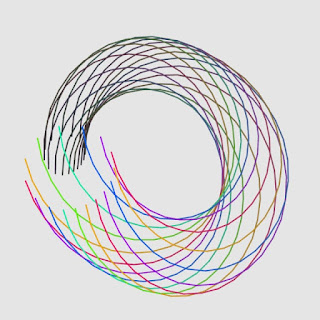The creative coding vertex Ouroboros.
The headless Ouroboros.
It's a creative coding animation made with Processing. It draws a moving Ouroboros loop.
I used vertex() to draw in this code like this. Does it make sense?
int scaleMax = 3;
int spineMax = 3;
beginShape(LINES); // for example
int scaleMax = 3;
int spineMax = 3;
beginShape(TRIANGLE_FAN); // draw spine
With 'beginShape(LINES);'.
With 'beginShape(TRIANGLE_FAN);'.
Processing example code.
This code does not display any images on the screen but generates image files in frames directory. You can make an animation with these files.
Please feel free to use this example code under the terms of the GPL. To see other works based on my code is my pleasure. And my honor.
/**
* Reminiscing.
* A creative coding animation that draws Ouroboros loop.
*
* Processing 3.5.3
* @author @deconbatch
* @version 0.1
* created 0.1 2020.03.09
*/
void setup() {
size(720, 720);
colorMode(HSB, 360.0, 100.0, 100.0, 100.0);
smooth();
noLoop();
}
void draw() {
int frmMax = 24 * 6; // 24fps x 6s animation
int scaleMax = 16;
int spineMax = 32;
float moveRadius = min(width, height) * random(0.30, 0.35);
float bodyRadius = min(width, height) * random(0.1, 0.2);
float hueBase = random(360.0);
translate(width * 0.5, height * 0.5);
rotate(random(PI));
for (int frmCnt = 0; frmCnt < frmMax; ++frmCnt) {
float frmRatio = map(frmCnt, 0, frmMax, 0.0, 1.0);
background(0.0, 0.0, 90.0, 100.0);
ArrayList<PVector> currPvs = new ArrayList();
ArrayList<PVector> prevPvs = new ArrayList();
for (int spineCnt = 0; spineCnt < spineMax; ++spineCnt) {
float spineRatio = map(spineCnt, 0, spineMax, 0.0, 1.0);
float moveRatio = (frmRatio + spineRatio) % 1.0;
float spineX = moveRadius * cos(TWO_PI * moveRatio);
float spineY = moveRadius * sin(TWO_PI * moveRatio);
// calculate current spine
currPvs.clear();
for (int scaleCnt = 0; scaleCnt < scaleMax; ++scaleCnt) {
float pRadian = TWO_PI * (scaleCnt * 1.0 / scaleMax + map(sin(TWO_PI * (scaleCnt * 1.0 / scaleMax + moveRatio)), -1.0, 1.0, -0.05, 0.05));
float pRadius = bodyRadius * (0.5 + 0.6 * spineRatio) * map(sin(TWO_PI * (scaleCnt * 1.0 / scaleMax + moveRatio)), -1.0, 1.0, 0.6, 1.05);
float pX = pRadius * cos(pRadian) + spineX;
float pY = pRadius * sin(pRadian) + spineY;
currPvs.add(new PVector(pX, pY));
}
if (prevPvs.size() != 0) {
drawSpine(prevPvs, currPvs, hueBase, spineRatio);
}
// set previous spine
prevPvs.clear();
for (PVector pv : currPvs) {
prevPvs.add(pv);
}
}
saveFrame("frames/" + String.format("%04d", frmCnt) + ".png");
}
exit();
}
/**
* drawSpine draw Ouroboros spine.
* @param _prevPvs : coordinates of previous spine.
* @param _currPvs : coordinates of current spine.
* @param _baseHue : body color.
* @param _spineRatio : 0.0 - 1.0 which spine to draw.
*/
private void drawSpine(ArrayList<PVector> _prevPvs, ArrayList<PVector> _currPvs, float _baseHue, float _spineRatio) {
float divHue = 0.0;
strokeWeight(_spineRatio * 2.0);
stroke(0.0, 0.0, 90.0, 100.0);
beginShape(TRIANGLE_FAN);
for (int i = 0; i < _currPvs.size(); i++) {
vertex(_prevPvs.get(i).x, _prevPvs.get(i).y);
fill(
(_baseHue + divHue + _spineRatio * 60.0) % 360.0,
40.0 + 20.0 * _spineRatio,
40.0 + 20.0 * _spineRatio,
100.0
);
vertex(_currPvs.get(i).x, _currPvs.get(i).y);
divHue += 5.0;
}
endShape(CLOSE);
}
/*
Copyright (C) 2020- deconbatch
This program is free software: you can redistribute it and/or modify
it under the terms of the GNU General Public License as published by
the Free Software Foundation; either version 3 of the License, or
(at your option) any later version.
This program is distributed in the hope that it will be useful,
but WITHOUT ANY WARRANTY; without even the implied warranty of
MERCHANTABILITY or FITNESS FOR A PARTICULAR PURPOSE. See the
GNU General Public License for more details.
You should have received a copy of the GNU General Public License
along with this program. If not, see <http://www.gnu.org/licenses/>
*/
Yet another example image.














So rad...if you posted as a gif instead of raster it would do it more justice because its really cool
Wow! Thank you for your advice! 🙂👍